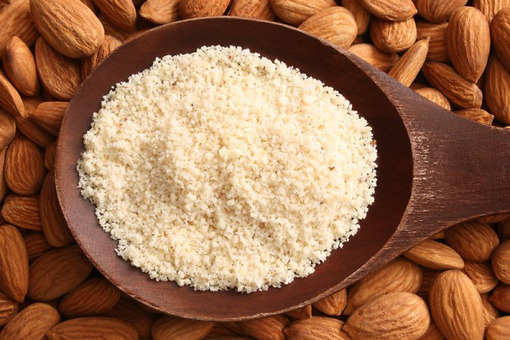Almond flour, albeit not popularly consumed, has several health benefits as compared to processed flours. Among tree nuts, almonds are the most nutritious. Thus, almond flour nutrition facts will no doubt provide you with great benefits. Although almond flour and almond meal are terms that are used interchangeably, there are slight differences between the two. Almond meal is prepared by grinding almonds with skins and is thus slightly grainy. Almond flour, on the other hand, is prepared differently: almonds are first blanched and then ground after their skins have been removed. Almond flour has a much finer texture as compared to almond meal.
Almond Flour Nutrition Facts

1. Excellent Source of Energy
One quarter cup of almond flour alone can do the body good as this serving will provide the body with roughly 140 calories, 11 grams of fat and 5 grams of protein. Moreover, 75% of the 11 grams of fat is monounsaturated fat which is considered good fat and is in fact good for the heart. Since almond flour naturally contains no cholesterol, it is a great food to include in diets of those people who have heart problems or are looking to lose weight. Moreover, almond flour contains 6 grams and 3 grams of carbohydrates and fiber respectively.
2. Packed with Vitamins
Almond flour is also packed with a variety of vitamins including vitamin B-12 such as folate and niacin and vitamin E. The latter is known for its antioxidant properties and helps to keep the skin healthy. It also bolsters the immune system of the body by protecting body cells from damage due to free radicals. A quarter cup of almond flour alone fulfils approximately 40% of the body's daily vitamin E recommended intake.
3. Full of Minerals
Other than vitamins, almond flour also contains certain essential minerals such as phosphorous, potassium and zinc. Almond flour is also a rich iron source. Most importantly, almond flour is a very good source of calcium which is needed by the body for optimal bone health. Although milk is generally perceived as the best source of calcium, one cup of almond flour has roughly the same calcium content as one cup of whole milk.
4. Good for Heart
With the great almond flour nutrition facts, its health benefits for the body are tremendous. In fact, almonds on their own or as flour are considered extremely advantageous for the health of the heart. They contain good fats i.e. monounsaturated fats that are known to reduce cholesterol levels, help substantially lower blood pressure and also lower the risk of blood clot formation in the body. Due to all these various benefits and the fact that it contains the right amount of fat, cholesterol, sodium and vitamins, almond flour qualifies as an extremely healthy food item for the heart.
5. Excellent for Baking
Almond flour's popularity is not on account of its nutritional benefits alone. In fact, it is very commonly used in baking; almond flour contains the ideal amount of fats and proteins making it an excellent ingredient for making cakes, cookies, muffins and bread. Another huge benefit of using almond flour in a variety of dishes in place of whole-wheat or white flour is that unlike these other flours, almond flour is extremely filling. Hence, it can play a key role in weight management by providing a feeling of fullness in between meals. In order to best preserve almond flour, it is recommended to store it in the refrigerator.
Can I Make My Own Almond Flour?
Yes, you can. With all the great almond flour nutrition facts, it's absolutely a good idea to make some at home. Several recipes require almond flour to be used in place of other processed flours. Fortunately, it is quite easy to make almond flour at home.
- First, almonds should be soaked overnight. The soaking process eliminates enzyme inhibitors thereby allowing stomach enzymes to work. This ensures smooth digestion of almonds.
- In order to blanch the almonds, simply drop in hot boiling water for a few minutes in an uncovered pan. The almonds should then be left to cool down.
- Once cooled, the skins should be peeled off using your fingertips or a cloth. Pat the blanched almonds with a towel paper or a cloth to get rid of any moisture.
- Once completely dry, almonds should be put in a blender or food processor. Switch the processor on and grind the almonds for thirty seconds or more until a grainy consistency is achieved. You can pulse the almonds up to a minute especially if you want them to have a finer texture.
- At this stage, you need to be careful as to not grind the almonds too much. This is because, excessive grinding will result in the formation of butter. Almond flour should be used right away or can be stored in the fridge for about three to six months.
What Is the Difference Between Natural and Blanched Almond Flour?
Almond flour is available in two varieties; blanched and natural. The only difference between the two kinds is that blanched almond flour is made using blanched almonds while natural almond flour is made using normal almonds. Almonds are blanched by dropping them into hot boiling water. This makes it easier to remove the skin off the almonds. These are then ground to make blanched almond flour. Natural almond flour, on the other hand, is simply made by grinding almonds with their skins on. For best results, it is better to slice the almonds finely before grinding them in a blender. Also, it must be ensured that the blades of a blender or food processor are correctly placed. This is to make sure the grinding process goes as smoothly as possible. Some people, especially bakers, prefer to use blanched almond flour due to its finer texture and lighter colour. This yields lighter colored cakes and breads.
